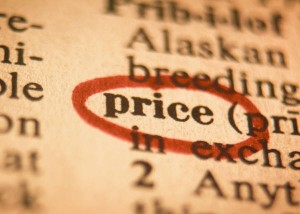 Pricing is complicated, especially if you want to make a profit. And who doesn’t?
Pricing is complicated, especially if you want to make a profit. And who doesn’t?
Depending on the size of your company, you may have to study every factor affecting it to create a proper price point—the sweet spot where expenses end and profit begins. The challenge is that sweet spot varies depending on market share, positioning, strategic objectives, methodology, competition and more. But until and unless you determine what is that spot for your business, you won’t survive, let alone make a profit.
The Basics:
There are two core elements to examine to price properly—cost of goods and operating expenses.
Cost of goods includes every cost up to and including shipping and handling—raw materials, plus any additional costs necessary to get the merchandise into inventory and ready for sale. Depending on the size of your operation, this may or may not be a complex process, so here’s an easy way to figure it out: walk through it—physically or mentally—forward and backward. Taking the time to do this will show you each and every step in the process, each and every factor affecting what it costs you to get your product/service out the door and into the hands of your customers.
Once you know that, determine your operating expenses: what does it cost you to run your business, including rent, utilities, wages, supplies, insurance, marketing, advertising, and any other expenses you may be incurring along the way? The easiest way to uncover any hidden costs is to check against your inventory valuation, expense statement or budget, which will uncover any fixed or variable expenses you may have missed.
Now that you have determined your unit price, add to that number the amount of profit you want for that specific product/service (percent or a fixed amount). You now have a price (temporarily), which should more than cover the cost of obtaining the goods PLUS the expenses related to operating the business. (Selling your products or service below cost will put you out of business, so let’s ignore the concept of loss leaders unless you’re a mega-giant in your industry or can afford to take the hit otherwise.)
What Else to Consider:
Now, consider your business and personal objectives. What exactly do you want accomplish? How much profit do you really need or want to make? Will one price level or model achieve your objectives? But this first is most critical: What exactly do you want to accomplish? (When you know your costs, and you know the answer to this question, the rest will fall into place.)
And:
Pricing has no “one size fits all” answer that works for every size company, but there is a sequence of steps that can be followed to develop the pricing that works for you. They’re interrelated, and don’t necessarily have to be followed in order, but you can use them simply as guideposts to consider or eliminate in determining what’s right for you and your business.
- Develop a marketing strategy (market analysis, targeting, positioning, objective, etc.)
- Consider the marketing mix (i.e., product, price, place, promotion – define the product, distribution, promotional tactics)
- Estimate the demand curve (customer preferences, prices of related goods, income, number of potential buyers, expectations of a price change)
- Calculate costs (fixed and variable)
- Consider environmental factors (competitor actions, legal constraints, etc.)
- Set pricing objectives (maximize profit, revenue, quantity; recover costs, stabilization, survival, etc.)
- Determine pricing (method, structure, discounts)
The Bottom Line:
In the end, whatever price you decide above your break-even ultimately will be determined by the consumer—what are they willing to pay for your specific product/service? Be willing to test and re-test the price, then follow with analysis.
For example, if your objective is to get more customers, you may want to set a moderate price point, particularly if you have a track record of being able to upsell and cross-sell to your customer base successfully. If you want to gain more profit, then you might consider setting a higher price point, which will generate fewer but potentially more profitable customers.
The Critical Factor:
The trick is to know your basic costs, to understand your market, and not to be afraid of taking a chance on creating the kind of profit and success you really want.

